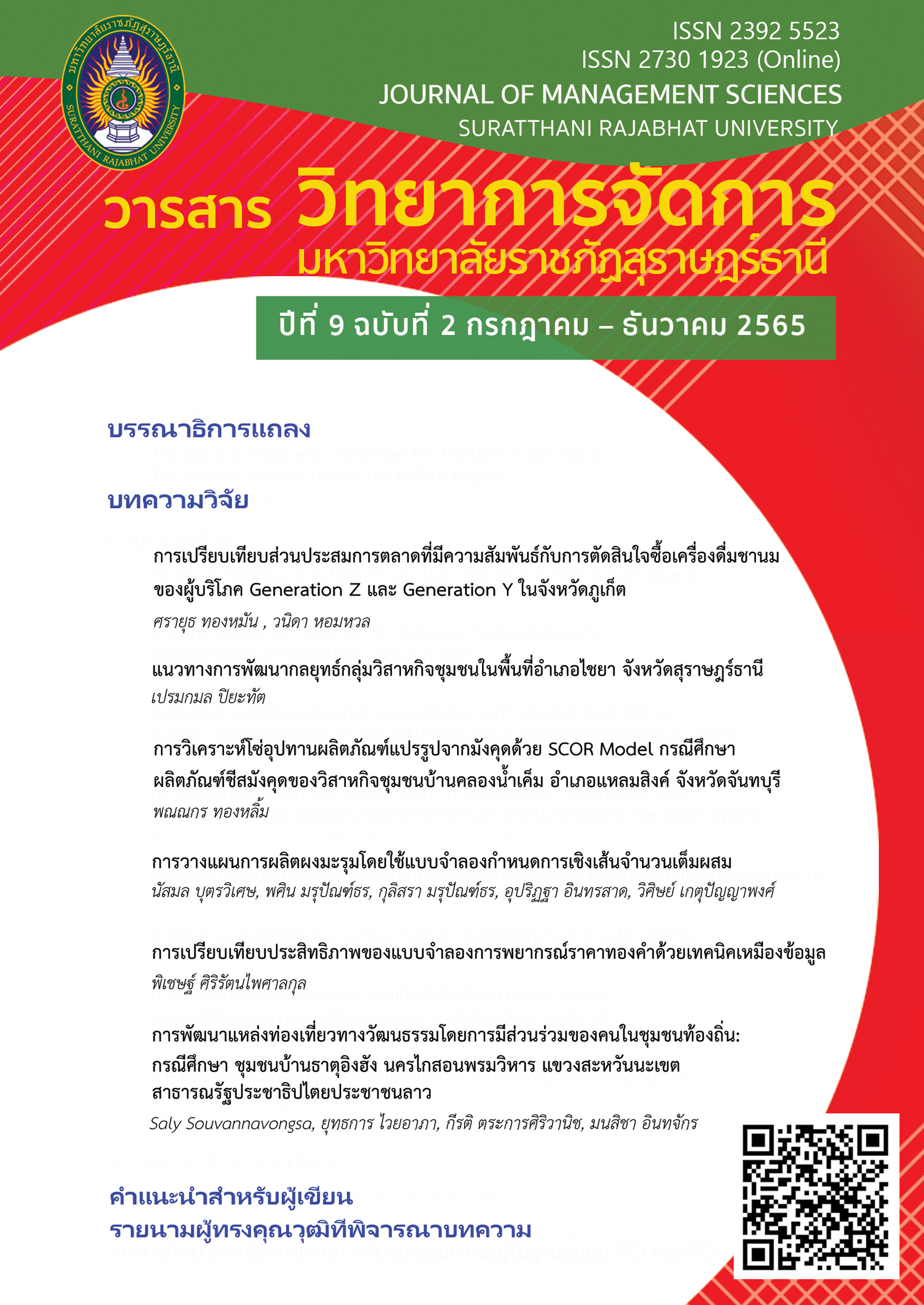Efficiency Comparison of Gold Price Forecasting Models with Data Mining Techniques
Main Article Content
Abstract
Gold is a valuable asset. When crises happen, the price of gold will rise, but in a normal situation, the prices of gold may decrease or remain stable. For this reason, gold prices can go up and down depending on the situation. This research aimed to study and compare the efficiency of gold price forecasting models using data mining techniques. It used gold price data from 2 January 1990 to 31 December 2020 for a 30-year learning period of 7,885 items and data from 2 January 2021 to 30 June 2021 of 131 items as data for various model tests. The review of related research found that the most popular forecasting models were the Box-Jenkins model, Holt-Winters model, and Artificial Neural Network (ANN). The researcher selected Linear Regression Analysis and Support Vector Machine (SVM) to differentiate from previous research. To measure the efficiency of the model, it used Root Mean Square Error (RMSE) and Mean Absolute Error (MAE). The results of the study found that using data for learning, Box-Jenkins model, where the optimal parameters are window size = 120, p = 0, d=1, q = 1 (ARIMA(0,1,1)) generates minimal RMSE. It can be used to forecast the gold price appropriately. The results showed that Box-Jenkins can be used to forecast gold prices most appropriately. The gold trade association determines and announces the gold price of Thailand. Box-Jenkins model can be used to forecast gold prices to plan decision-making up-down gold price futures and Gold traders can use the forecasted gold price to plan gold purchases to manage their warehouses to achieve reasonable costs.
Article Details

This work is licensed under a Creative Commons Attribution-NonCommercial-NoDerivatives 4.0 International License.
References
Akash Dutt, D. (2016). Gold price prediction using support vector regression and ANFIS models. 2016 International Conference on Computer Communication and Informatics (ICCCI) (p.1-6). Coimbatore, India: IEEE. doi:10.1109/ICCCI.2016.7479929
Ali, A., Ch, M. I., Qamar, S., Akhtar, N., Mahmood, T., Hyder, M., & Jamshed, M. T. (2016). Forecasting of daily gold price by using box-jenkins methodology. International Journal of Asian Social Science, 614-624.
Chanaboon, S. (2017). linear regression analysis. (Khon Kaen Provincial Health Office). http://www.kkpho.go.th/i/index.php/component/attachments/download/1933.html
Elizabeth, R., & Sitorus, S. (2021). Gold Price Forecasting Using Autoregressive Integrated Moving Average (ARIMA) Method. Journal of MathematicsTechnology and Education, 11-18.
GmbH, R. (2019). RapidMiner 9 Operator Reference Manual. London: RapidMiner.
Goganutapon, K. (2020). A Comparison of the Forecasting for the Sale Price of Gold Bar. YRU Journal of Science and Technology, 5(1), 1-9.
GoldPrice. Org. (2022, February 6). From Goldprice. Where The World Checks Historical Gold Prices. https://goldprice.org/30-year-gold-price-history.html
Guha, B., & Bandyopadhyay, G. (2016). Gold Price Forecasting Using ARIMA Model. Journal of Advanced Management Science, 117-121.
Inplang, W., & Thongkam, J. (2020). Opinion analysis on PlayerUnknown's Battlegrounds (PUBG) mobile games using text mining. J Sci Technol MSU, 523-531.
Kaewhawong, N. (2013). A Comparison of Pegels, ARIMA and Pegels-ARIMA Hybrid Models in Forecasting Thailand’s Mango Export Value. Thai Science and Technology Journal Thammasat University, 578-593. https://li01.tci-thaijo.org/index.php/tstj/article/view/14539/13311
Kangarani Farahani, M., & Mehralian, S. (2013). Comparison Between Artificial Neural Network and Neuro-Fuzzy for Gold Price Prediction. 13th Iranian Conference on Fuzzy Systems (pp. 1-5). Qazvin, Iran: IEEE. doi:10.1109/IFSC.2013.6675635
Khangphukhieo, W., Busababadhin, P., & Bung-on . (2017). Forecasting Volatility of Gold Price with Artificial Neural Networks. Burapha Science Journal, 125-134.
Khumsin, P., & Banditvilai, S. (2017). Comparison of the Sales Forecasting Models for the Air Conditioners by Holt-Winters Exponential Smoothing Method, Box-Jenkins Method and Artificial Neural Networks. Thai Science and Technology Journal Thammasat University, 363-376.
Kiangkham, D. (2017). Complete Excel 2016 User Guide. Nonthaburi: IDC Premier, Co., Ltd.
Pacharawongsakda, E. (2019). Practical Data Mining with RapidMiner Studio 9. Bangkok: Publisher of Asia Digital Printing Co., Ltd.
Ratchalame, W., & Kanjanasamranwong, P. (2018). Factors Affecting Gold Bullion Price in Thailand. Journal of Science and Technology, Ubon Ratchathani University, 21(1), 155-165.
Sarasiri, A. (2016, January 31). Techniques for learning the fundamentals of neural networks. https://www.mut.ac.th/research-detail-92
Sittichat, S. (2017). Study of Educational Attributes Using Data Mining Technique. Information Technology Journal, 20-28.
th.investing.com. (2021, July 10). Gold Futures Historical Data. https://th.investing.com/commodities/gold-historical-data
World Gold Council. (2021, July 19). Gold Demand Sectors. https://www.gold.org/about-gold/gold-demand/sectors-of-demand
Yuk, W., & Thongkam, J. (2018). Comparison of Time Series Techniques for Predicting Gold and Oil Prices. RMUTI JOURNAL Science and Technology, 154-167.


